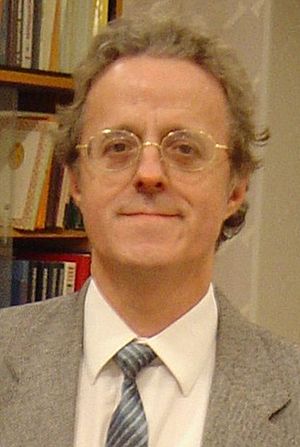Antonio Castellanos Mata facts for kids
Antonio Castellanos Mata (born March 7, 1947 – died January 27, 2016) was a Spanish physicist. He was known for his important work in areas like electrohydrodynamics, which studies how electric fields affect liquids. He also researched how electricity behaves in gases and how tiny particles like powders move.
Contents
About His Life
Early Life and Education
Antonio Castellanos Mata was born on March 7, 1947, in a small town called Antoñanes del Páramo near León, Spain. A few years later, his family moved to the city of León. He was the youngest of three children. His father, Manuel Castellanos Berjón, was a school teacher.
When he was a child, Antonio was very religious and thought about becoming a priest. While studying in a seminary (a school for training priests), he started learning about mathematics and physics on his own. He was very curious! He was expelled from the seminary a few months before he was supposed to finish.
Antonio then went to the University of Valladolid. He worked very hard and earned the first PhD in physics ever given by that university. A PhD is a very high degree that shows someone is an expert in their field. He also received a special scholarship called a Fulbright scholarship. This allowed him to spend a year studying at the Ohio State University in the United States.
Family and Friendships
Antonio Castellanos Mata made many scientific friends and worked with researchers from different countries. One of his close friends was Pierre Atten, who helped Antonio become very interested in electrohydrodynamics.
Antonio Castellanos Mata married María Elena Navarrete Sandoval in 1975. They had a son, Antonio, and a daughter, Dayeli Anahí. Later, in 2006, he married Elena Grekova, and they had two sons together.
In 2014, doctors found out that Castellanos Mata had kidney cancer. He passed away on January 27, 2016. Even until the end of his life, he kept teaching classes, doing research, and leading scientific projects. He was truly dedicated to his work.
His Scientific Work
Antonio Castellanos finished his PhD in 1972 at the University of Valladolid. His research was about something called "Dispersion theory."
He worked at many different universities, including the University of Valladolid, the University of the Basque Country, and the Autonomous University of Madrid. In 1983, he became a full professor at the University of Seville. This means he was a top-level teacher and researcher there.
Antonio also spent a lot of time visiting and working in other countries like the USA, France, Nicaragua, and Russia. He also worked with scientists from the UK, the Netherlands, and China.
He studied many different areas of science, such as:
- Electrohydrodynamics: How electric forces affect liquids.
- Gas discharges: How electricity moves through gases, especially at normal air pressure.
- Cohesive granular materials: How tiny particles like sand or powders behave when they stick together.
Research Group and Teaching
Antonio Castellanos Mata started a special research group at the University of Seville. This group focused on Electrohydrodynamics and Cohesive Granular Media. Today, this group has more than 20 researchers!
Throughout his career, he taught physics at various universities. For his last 33 years, he taught electrodynamics and electromagnetism at the Faculty of Physics at the University of Seville. He also led research projects for over 30 years, which helped him create two laboratories at the university.
Antonio was very interested in pure science, but he also liked to solve real-world problems. He worked with big companies like Xerox Corporation, Novartis, and Dow Corning. He wrote more than 350 scientific papers, and other scientists have mentioned his work over 7,800 times! This shows how important his research was.
Key Discoveries
Some of his important discoveries and contributions include:
- Understanding how electromagnetism works in certain situations.
- Developing equations to describe temperature and energy in electrohydrodynamics.
- Studying how liquids move in specific patterns.
- Creating ways to use computers to simulate (or model) how electrohydrodynamic flows behave.
- Figuring out why certain liquids become unstable when electricity is applied.
- Studying how energy moves in turbulent (choppy) electrohydrodynamic flows.
- Finding ways to make liquid bridges (like a drop of water connecting two surfaces) stable using electric fields.
- Developing theories for how electricity affects liquids in very small systems, like those used in tiny devices.
- Discovering that fine powders don't behave like liquids in certain ways.
- Creating a model for how two tiny powder particles touch and interact.
- Studying how fine particles behave in a "fluidized bed" (where air makes them act like a fluid), including how they clump together and change from solid-like to fluid-like.
Awards
- He received the FAMA Prize from the University of Seville in 2013 for his amazing research career.
See also
 In Spanish: Antonio Castellanos Mata para niños
In Spanish: Antonio Castellanos Mata para niños


